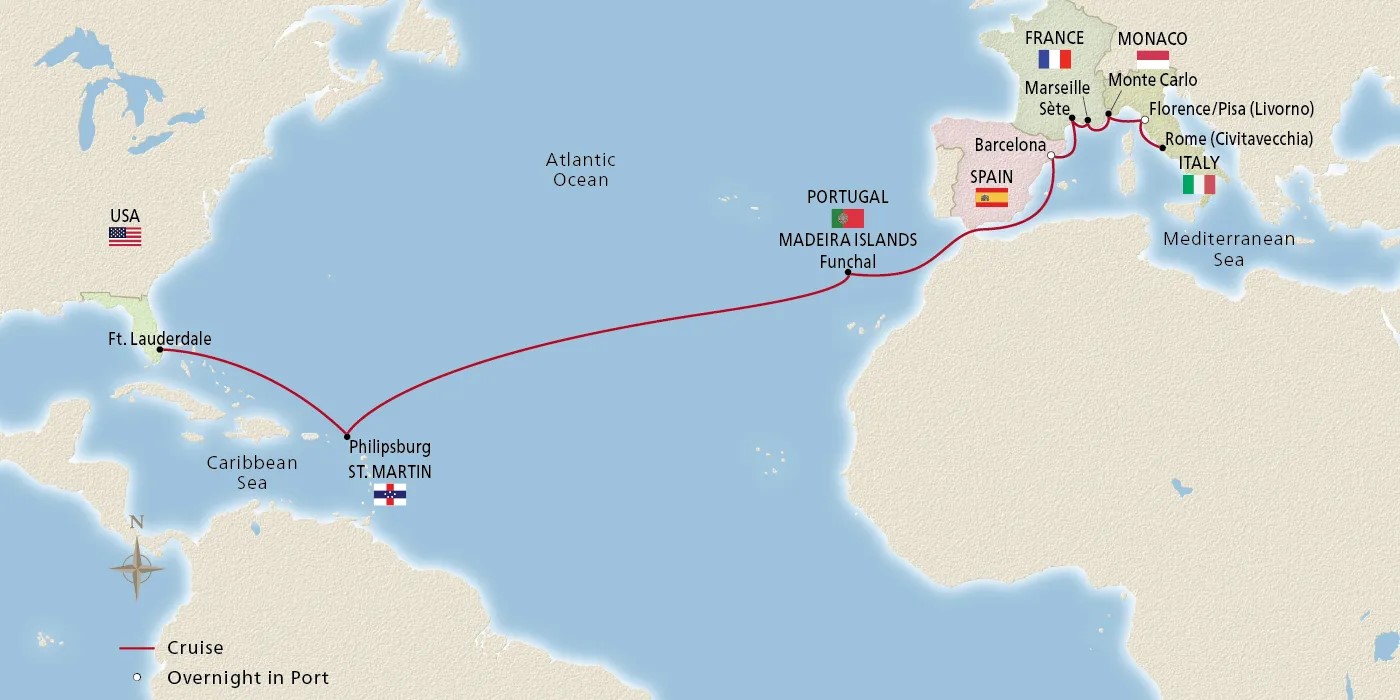Onboard Spending
In this section we will take a look at how much you spend onboard once you are on the cruise. I’ll save shore excursions for the next section.
Before we dig in, let’s take a look at a fast way to estimate your shipboard account at the end of your cruise. For this method you calculate your average daily spending on your previous cruises and then use that average to calculate your future spending. For this we assume that your daily spending on previous cruises is a good predictor of your daily spending on future cruises. But is this a good assumption? Will you spend more or less per day on a longer cruise than on a shorter cruise?
One easy way to do this on HAL is to go to your account on Holland America and then go to your “My Mariner Status” page. Below is the data from my account. You will see a table similar to this in your account except you won’t see the column labeled spending ratio as that is my own calculation. The spending ratio is a ratio of the number of actual days vs onboard spending credit days. This column also includes spending before the cruise if you bought HAL excursions or indulgences in advance.
| Days |
OnBoard Spending Days |
Spending Ratio | |
| Panama Canal | 16 |
8 |
50.00% |
| World Voyage | 115 |
46 |
40.00% |
| Alaska Southbound Gulf | 7 |
6 |
85.71% |
| Canada New England | 7 |
2 |
28.57% |
| Circle Hawaii | 17 |
7 |
41.18% |
| Europe Northern | 14 |
6 |
42.86% |
| South America Explorer | 13 |
9 |
69.23% |
| Europe Northern | 7 |
4 |
57.14% |
| Average spending ratio before world cruise | 54.1% | ||
This table can help you look at your own long term trends and patterns. In my case, my ratio before the cruise was 54% and on the cruise was 40%. Based on this analysis, I would suggest that you should probably discount your non-world cruise daily rate by 25% to get a more accurate prediction of your expected spending on a world cruise.
This approach doesn’t take into account your spending off the ship or on private excursions, but this is a quick and dirty method to at least get you in the ball park.
My conclusion based on this VERY limited data is that you will probably spend less per day on a world cruise then you would on your shorter cruise, but take a look at your own data and it can help with your world cruise budgeting.
There are numerous ways for you to spend your money onboard. When you are thinking about your budget for a world cruise, take a look at this list of how you could spend your money. Sometimes on a longer cruise you may want to try something new so reviewing this list may help jog your thinking:
Beverages
- Specialty Coffees
- Beer
- Wine
- Cocktails
- Soft Drinks
- Bottled Water
- Wine Tastings
- Other tastings and beverage classes
Specialty Restaurant Dinners
- Canaletto’s
- Pinnacle Grill
- Theme Dinners
Spa
- Massages
- Haircuts, styling and treatments
- Mani/Pedi
- Thermal Suite
- Specialty Treatments
OnBoard Shops
Casino
- Table Games
- Slots
- Slot and Blackjack Tournaments
- Texas Holdem
Internet
Art Auctions
Fitness Center
- Pilates Classes
- Spinning Classes
- Personal Training
Culinary Arts Center Classes
BINGO
You will receive a statement of your charges at the end of every segment. This is your chance to correct any errors. HERE is a copy of the letter from the Purser that explains how the billing works on a world cruise. The letter says that only the summary of each segment will be carried over, but I received an 11 page account summary at the end of the cruise anyway.
Right outside the front desk was an ATM looking machine that would print out your onboard account statement at any time on demand. Unfortunately, it was out of order most of the cruise so it didn’t turn out to be very useful, however, the front desk would always cheerfully print your statement whenever you asked.
Below is a spreadsheet that can help you predict your total spending for a world cruise, or for that matter, any cruise as you can enter whatever input numbers you choose.
The areas in green can be changed or you can simply leave the numbers alone to use the default values. The numbers in yellow or gray are calculated from other cells and cannot be modified except by changing the values in the input cells.
Here the instructions, block by block:
Number of passengers – enter 1 or 2 – this spreadsheet will not work for more than 2 people.
Enter the passengers ages. This will estimate the cost of your travel insurance. If you don’t want to price in travel insurance, enter zero for passenger ages. Add in the cost for medical evacuation insurance as a separate item under “Other pre/post cruse costs”.
In a suite? This answer will decide which Hotel Service Charge to use for your calculations.
Normal HSC and Suite HSC – the values here are for Holland America in 2016. Enter the values for your cruise line.
HSC Prepaid? Under certain circumstances and cabin categories, the HSC may be prepaid. Enter Yes or No as appropriate.
Base Cruise Fare: Enter the base fare for your cruise for one person. The spreadsheet will multiply this by the number of passengers you entered earlier. If you are a single, enter the fare with the single supplement included.
Port Charges: Enter the port charges and taxes for your cruise.
Travel Agent Discount: Enter the amount of your travel agent discount per person. If you’d rather simply enter a lower fare into the base cruise fare, then that is OK too.
Enter the number of sea days: This is used as a multiplier for onboard consumption on sea days.
Enter the number of port days: This is used as a multiplier for onboard consumption on port days.
Total Airfare/Car: Enter the round trip airfare or the cost of your other transportation to and from the cruise port.
Pre/Post Cruise Hotel: Enter the cost of any hotels you plan to stay in before and after the cruise.
Transfers: Enter the total cost of your transfers from the airport to your hotel and then to the ship and then the same on the return.
Baggage Shipment: If you plan to ship bags separately enter $100 per bag if you are in the USA or CANADA otherwise $250 a bag elsewhere.
OBC: Enter the total amount of Onboard Credits you will receive.
The next section, left hand column, gives you a chance to enter the prices for various items sold or offered onboard. I have entered approximate prices for many items. If you want to use different prices, you can enter them here. If you are happy with these prices, you can leave them alone. For the price of shore excursions, enter the average price of a single shore excursion. This number will be multiplied by the number of passengers you entered earlier.
For shore meals, souvenirs and internet minutes, enter the total amounts for both passengers.
The onboard usage will be entered into the next two columns. In these columns, enter the expected usage for both passengers. If you have a drink every other day enter .5, every third day .3 and so on. Rough numbers are fine here as you are simply trying to get a ball bark estimate.
The pricing for the internet is based on the HAL rates and the spreadsheet uses the least expensive rate based on your total minutes.
| Minutes | Price | Rate |
| 1000 | $250 | 25 cents/minute |
| 500 | $175 | 35 cents/minute |
| 250 | $100 | 40 cents/minute |
| 100 | $55 | 55 cents/minute |
| Pay as you go | NA | 75 cents/minute |
On the lower right side, you can enter your expected Casino losses and how much you expect to spend in the onboard shops.
Lastly, there is a block to enter Other Charges. Here you can enter anything you may have overlooked elsewhere.
Once you have numbers in all the green blocks, you will see the estimated TOTAL price of your cruise in the YELLOW BLOCKS.


Great information. Thanks.
I have a question about the “wine by the glass” charge. Could you explain this a bit more? Is the charge you mentioned good for 1 glass of wine per day for the entire cruise or for sea days only or something else?